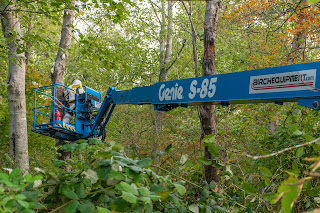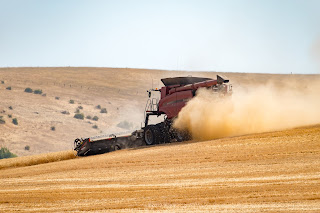Karla Salp
Communications
 | |
| WSDA's Pest Program uses a buck lift to access the nest 15 feet up in an alder tree |
Most research on these hornets suggests that they
normally nest in the ground and more rarely in trees. But so far, 100 percent of
nests found in Washington have been in tree cavities. The entrance to this
latest nest was over 15 feet above the ground. A thermal-imaging camera showed
the nest itself was below the nest entrance.
Just as in the other nest removals, once at the entrance, the
team sealed up the tree and vacuumed most of the hornets out before sealing the
entrance.
 |
| Inspiring Halloween costumes everywhere - Dan DeVoe prepares to take down the tree with the nest |
In addition to the height of the nest, it was also in a decaying alder tree. This made it risky to safely cut the tree down. A trail steward from the Department of Natural Resources was able to help. Wearing a bulky hornet suit, he cut the tree so it dropped right on target. Once the tree was down, he cut it into sections and split the tree open so the team could finish collecting the remaining hornets and the nest.
 |
| Queen and the nest |
- 10 combs
- 674 total cells
- 86 empty cells
- 128 eggs
- 202 larvae
- 261 capped cells
- 185 workers
- 0 males
- 1 queens
- TOTAL LIFE STAGES – 777
Luckily, none of the three nests eradicated this year have
had new queens, meaning the nest was found and removed before the queens could emerge,
mate, and left to start new nests next year.
Two of the three nests this year were found from reports
made by local residents, and this is the critical time to find nests before
creating new queens. If you think you see an Asian giant hornet, take a photo
and submit a report at agr.wa.gov/hornets.
 |
| WSDA/DNR/USDA team that removed the third nest of 2021, fourth nest total |
Video of activity at the nest as well as the nest removal is available on WSDA's YouTube channel.








